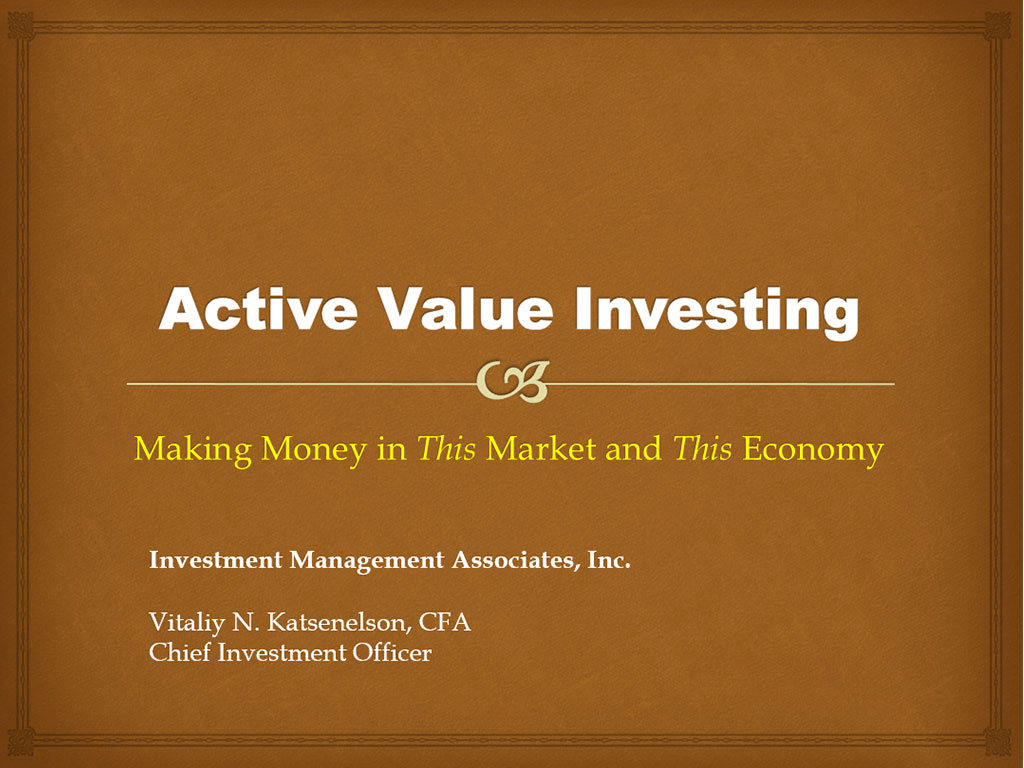The stock market has dropped. Corporate profits have collapsed. And profit margins have reverted toward the mean. What is next?
Before I dive into the discussion, let me explain the chart below, which I named appropriately, “The pain of mean reversion.”
I looked at reported earnings for S&P 500 and compared them to the “average case” earnings scenario. In the “average case” scenario I took reported earnings of S&P 500 in the early 1990s and grew them at 6% — an average growth rate of GDP over the last century which happens to be the same as earnings growth for stocks during the same century.
If the economy had no cyclicality and profit margins remained constant, you would see nice, steady growth earnings for S&P 500 stocks like the one in the chart.
Of course, profit margins do not stay constant — they fluctuate, thus actual earnings swing above and below the steady 6% trend line.
How far will earnings drop?
You’ll never go wrong quoting Mark Twain when he said “History doesn’t repeat itself, but it does rhyme.” Our challenge as investors is to look at the past and figure out how history will rhyme with the future.
If you were to look at the recent history of the 2001 recession, earnings dropped 54% from their highs to their lows. If S&P 500 reported earnings were to drop by the same amount this time around they’d be at about $39. We are already below that level, 2008 estimates for S&P 500 were revised down again, now to $28. However, this is where Twain’s rhyming thinking becomes important — note that in 2001 earnings went only 18% above the “average case” line; in 2007 they were 31% above that line. If we were to follow the higher they climb the harder (deeper) they fall logic, this would lead us to believe that earnings will drop further this time, estimates for early 2009 earnings indicate that.
When will we see average earnings?
The good news is S&P “average case” earnings are about high $70s to low $80s a share (see big red squares in yellow shaded area) — which would make the market cheap (with a PE of about 10). But here is the bad news (don’t shoot the messenger please) — we just won’t see those “average case” numbers for a while.
The 2001 recession was driven by the overcapacity in the corporate sector. Corporations rationalized their inventories and factories, higher unemployment followed — we were in a recession. Excesses were worked out, corporations started to hire, and voila — we were out of the recession. Of course the recovery process was also aided by a “friendly” Fed, it took interest rates to (at the time) an unprecedented low levels and kept them there until corporations and consumers got seriously drunk on cheap money and spent themselves into serious debt for which we are paying now.
In the 2001 recession it took two and a half years for earnings to rise from their bottom to their average.
Unfortunately we’ll not be that lucky this time — we are in a consumer recession. Consumers are two thirds of the economy and they are deleveraging. As a side note: This deleveraging goes beyond big ticket discretionary items like large screen TVs and SUVs. Now it is showing up in lower consumption of staples like iced tea by Snapple which competes with cheapest commodity of all — tap water. Now, more expensive branded products like diapers and tissue made by Kimberly Clark are forced to compete with generic store brands. The meaning of the word staple is being redefined by this economy.
The Fed, being even “friendlier” than the last time, has lowered interest rates to almost zero, buying long-term bonds etc. But this time around the Fed’s booze will not do the trick — consumers are still suffering a hangover from the last Fed’s “help” — they don’t want to borrow and banks, after incurring huge losses, are behaving like real banks — only giving loans to people who’ll pay them back.
In addition to consumer deleveraging, government debt is skyrocketing with every bailout, thus taxes and interest rates are likely to be significantly higher once the economy normalizes.
The Earnings recovery will likely take longer than many expect, therefore, there is a very high possibility that the “average case” earnings growth going forward will be below the historical average of 6%.
Are we about to embark on a secular bull market?
The market is a discounting mechanism — stocks will rise in the anticipation of a future earnings rebound, before the rebound. Similar to the stock market forecasting ten out of the last three recessions, it will discount a few recoveries before the real one takes hold.
What does this mean? We’ll likely have a few “fake” head starts and disappointments before the actual earnings recovery takes place.
As I argued in my book Active Value Investing: Making Money in Range-Bound Markets, we are very likely in the midst of a secular range-bound (trendless, volatile but going nowhere) market that started in early 2000. Historically, range-bound markets started at the end of the secular bull market when P/Es were above average. They ended when P/Es stopped declining (mean reverting), after a visit to below average territory (around 10-11 or less). The current range-bound market started at much above average valuation and will likely rhyme with the past finish at below average valuation as well.
Based on the Pain of mean reversion chart we are trading somewhere between 30 and 10 times earnings. However, neither number is very meaningful. Let me explain:
1. 2008 estimates of $28, the “E” in P/E of 30, are distorted by massive charge offs.
2. The “average case,” the “E” ($80) that went into P/E of 10, lies in a far away land that … well, let me put it this way, you and I will get to grow sick of presidential campaign advertisements at least once or maybe even twice before that “E” is in sight.
3. Even based on 2010 “E” estimates ($40) stocks in the S&P 500 are trading at 21 times earnings.
Despite the decline, the market is still not cheap. Sorry, we are not likely to embark onto the new secular bull market anytime soon. History and data suggest that the choppy markets that we have seen since 2000 will likely continue. Owning a broad market index will not pave a road to prosperity. It comes down to not just owning stocks but owning the right stocks.
P.S. As a side note I believe significant earnings write-offs will continue well into next year as financial stocks will pass their write-off torch to companies in energy, materials and industrial sectors — stuff stocks — that will be writing off the investments they’ve made over the last five years.
By the time, I finished putting these thoughts together, which on and off took about two weeks, 2008, 2009 and 2010 estimates were taken down by about 20-25%.










0 comments